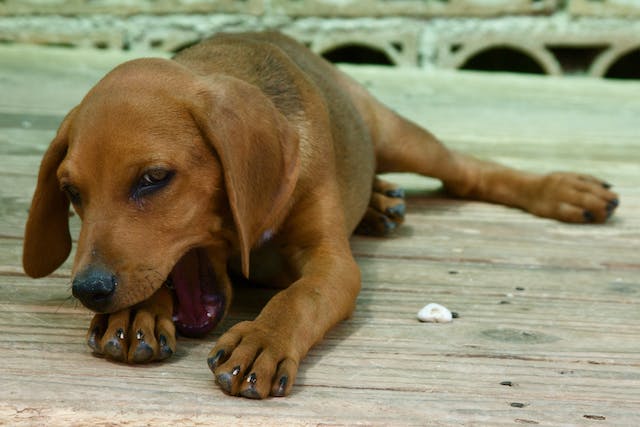Unlocking the Mystery: Why Does My Dog Flinch When I Pet Him?
As pet owners, we often seek to provide love, care, and affection to our furry companions. Petting our dogs is one of the ways we express our affection and strengthen the bond we share with them. However, have you ever noticed your dog flinching or showing signs of discomfort when you try to pet them?
This behavior can be puzzling and concerning for dog owners, leaving them wondering why their beloved pets react this way. In this article, we will delve into the possible reasons behind why dogs may flinch when being petted and explore ways to address this issue.
It is important to note that every dog is unique, and their individual experiences and personalities can influence their reactions. Therefore, it is crucial to approach this topic with an understanding that there might not be a one-size-fits-all explanation. However, by examining some common factors and considering the principles of canine behavior, we can shed some light on this intriguing phenomenon.
One possible explanation for a dog’s flinching behavior when being petted is related to their past experiences. Dogs, like humans, can have traumatic experiences or negative associations with certain actions or stimuli. If a dog has experienced pain, fear, or discomfort during previous petting sessions, they may develop a conditioned response to flinch as a protective mechanism.
Another factor to consider is a dog’s sensitivity to touch. Just like humans, dogs have varying levels of sensitivity to physical contact. Some dogs may have a lower threshold for touch and may find certain petting techniques or areas of their body more sensitive than others. This sensitivity can lead to a flinching response when they are touched in a way that exceeds their comfort level.
Additionally, it is important to recognize that dogs have personal boundaries and preferences. While some dogs enjoy being petted and seek out physical affection, others may not be as receptive. Each dog has their own unique preferences regarding touch, and forcing unwanted physical contact can cause them to flinch or display signs of discomfort.

Why Does My Dog Flinch When I Pet Him
Understanding why dogs flinch when being petted is the first step towards addressing this behavior and ensuring the well-being of our furry friends. In the following sections, we will explore practical recommendations and strategies to help alleviate their discomfort and promote positive interactions during petting sessions.
The Reasons Behind a Dog’s Flinching Behavior When Being Petted
When it comes to understanding why dogs flinch when being petted, several factors come into play. Let’s explore some of the key reasons behind this behavior:
Past Experiences and Conditioning
Past experiences play a significant role in a dog’s behavior. If a dog has had negative encounters during petting sessions, such as being handled roughly or experiencing pain, they may develop a conditioned response to flinch when touched. This flinching behavior serves as a protective mechanism, as they anticipate discomfort or harm.
It is crucial to approach petting sessions with patience and gentleness, especially if you are unsure about your dog’s past experiences. Building trust and providing positive associations during petting can help overcome any negative conditioning they may have developed.
Sensitivity to Touch
Just like humans, dogs have varying levels of sensitivity to touch. Some dogs may have a heightened sensitivity, making certain petting techniques or areas of their body more uncomfortable for them. For example, certain breeds or individual dogs may have more sensitive areas around their ears, paws, or tail.
Observing your dog’s reactions and respecting their boundaries is crucial. If you notice your dog flinching when you pet a specific area, it may be a sign that they are uncomfortable or sensitive in that particular spot. Adjusting your touch and avoiding those areas can help alleviate their discomfort.
Personal Boundaries and Preferences
Every dog has their own unique preferences when it comes to physical contact. While some dogs enjoy being petted and seek out affection, others may prefer more space and independence. It is essential to recognize and respect your dog’s personal boundaries.
Forcing unwanted physical contact can lead to a dog flinching or displaying signs of discomfort. Pay attention to your dog’s body language and cues. If they show signs of tension, such as stiffening or pulling away, it is best to give them space and allow them to approach you for affection when they feel comfortable.
Practical Recommendations for Addressing Flinching Behavior
Now that we understand some of the reasons why dogs may flinch when being petted, let’s explore practical recommendations to address this behavior:
1. Observe and Respect Your Dog’s Body Language
Pay close attention to your dog’s body language during petting sessions. Look for signs of discomfort, such as tensing up, lip licking, or trying to move away. If you notice these cues, stop petting and give your dog a break.
Respecting your dog’s signals and allowing them to set the pace for physical contact can help build trust and create a positive association with petting.

Why Does My Dog Flinch When I Pet Him
2. Gradual Desensitization
If your dog flinches when touched in specific areas, consider implementing gradual desensitization techniques. Start by gently touching the area for a brief moment and immediately reward your dog with treats and praise.
Over time, gradually increase the duration and intensity of the touch while continuing to provide positive reinforcement. This helps your dog associate the previously uncomfortable touch with positive experiences, reducing their flinching response.
3. Consult with a Professional
If your dog’s flinching behavior persists or is accompanied by other signs of anxiety or fear, it may be beneficial to seek guidance from a professional dog trainer or behaviorist. They can assess your dog’s unique needs and provide tailored strategies to address the issue.
4. Create a Positive Environment
Ensure that your dog feels safe and comfortable in their environment. Provide them with a designated space where they can retreat if they feel overwhelmed or need time alone.
Creating a positive and stress-free environment can help reduce overall anxiety and contribute to a more relaxed response during petting sessions.
Actionable Recommendations for Addressing Flinching Behavior
1. Observe and Respect Your Dog’s Body Language
When petting your dog, pay close attention to their body language. Look for signs of discomfort, such as tensing up, lip licking, or trying to move away. If you notice these cues, stop petting and give your dog a break. Respecting their signals and allowing them to set the pace for physical contact can help build trust and create a positive association with petting.
2. Gradual Desensitization
If your dog flinches when touched in specific areas, consider implementing gradual desensitization techniques. Start by gently touching the area for a brief moment and immediately reward your dog with treats and praise. Over time, gradually increase the duration and intensity of the touch while continuing to provide positive reinforcement. This helps your dog associate the previously uncomfortable touch with positive experiences, reducing their flinching response.
3. Avoid Triggering Sensitive Areas
Take note of any areas on your dog’s body that they may find particularly sensitive, as this can often lead to the question, “Why does my Dog Flinch When I pet him?” Common areas include the ears, paws, tail, or certain spots where they may have had past injuries. If you’ve ever wondered, “Why does my Dog Flinch When I pet him?” it could be due to discomfort or sensitivity in these specific areas.
Avoid touching or petting these areas if your dog shows signs of discomfort or flinching, which can be a clear answer to the query, “Why does my Dog Flinch When I pet him?” Instead, focus on areas where they enjoy being petted and provide positive reinforcement in those areas. This approach not only respects their boundaries but also helps in understanding the underlying reasons behind the concern, “Why does my Dog Flinch When I pet him?” By doing so, you can create a more trusting and comfortable environment for your dog, reducing instances where you might ask yourself, “Why does my Dog Flinch When I pet him?”
4. Use Calming Techniques
During petting sessions, it’s not uncommon to wonder, “Why does my dog flinch when I pet him?” To address this concern and help your dog relax, incorporating calming techniques can be incredibly beneficial. If you’re asking yourself, “Why does my dog flinch when I pet him?” it might be a sign that your dog is experiencing anxiety or tension. Gentle massage, slow and soothing strokes, or using a calming touch technique known as T-Touch can significantly reduce these feelings.
These methods are especially useful if the question “Why does my dog flinch when I pet him?” arises frequently during your interactions. They not only make petting sessions more enjoyable but also help in building a stronger, more trusting relationship between you and your dog. So, if you often find yourself puzzled by the thought, “Why does my dog flinch when I pet him?” consider these calming techniques as a way to alleviate their discomfort and enhance the bond you share with your furry friend.

Why Does My Dog Flinch When I Pet Him
5. Provide Positive Associations
To address the concern of “Why does my Dog Flinch When I pet him,” it’s essential to create positive associations with petting for your dog. Offering treats or favorite toys before, during, and after petting sessions can significantly reinforce positive experiences. This strategy is crucial in helping your dog associate petting with rewards and enjoyable interactions, thereby reducing their tendency to flinch or show signs of discomfort.
If you’re wondering, “Why does my Dog Flinch When I pet him,” integrating treats and toys into your interactions can be a game-changer. This approach not only addresses the issue of “Why does my Dog Flinch When I pet him” but also strengthens your bond with your pet. By consistently practicing this method, your dog will begin to look forward to petting sessions, making the question of “Why does my Dog Flinch When I pet him” less of a concern and transforming petting into a mutually enjoyable activity.
6. Seek Professional Guidance
If your dog’s flinching behavior persists or is accompanied by other signs of anxiety or fear, it may be beneficial to consult with a professional dog trainer or behaviorist. They can assess your dog’s unique needs and provide tailored strategies to address the issue. Professional guidance can be particularly helpful if your dog’s flinching behavior is severe or if you are unsure about the underlying causes.
7. Create a Safe and Comfortable Environment
Ensuring that your dog feels safe and comfortable in their environment is crucial, especially if you’re wondering, “Why does my dog flinch when I pet him?” Providing your dog with a designated space where they can retreat if they feel overwhelmed or need time alone can significantly help. If you’re asking yourself, “Why does my dog flinch when I pet him?” it could be a sign that your dog is experiencing stress or anxiety in their current environment. To address the concern of “Why does my dog flinch when I pet him?” it’s important to minimize loud noises, create a consistent routine, and ensure that their basic needs, such as food, water, and exercise, are met.
Creating a positive and stress-free environment can help reduce overall anxiety and contribute to a more relaxed response during petting sessions, thus addressing the question, “Why does my dog flinch when I pet him?” Additionally, when considering the issue of “Why does my dog flinch when I pet him?” it’s essential to observe your dog’s body language and respect their space, as forcing interactions can lead to discomfort and reinforce the flinching behavior.
By focusing on creating a safe and nurturing environment, you can help mitigate the reasons behind the question, “Why does my dog flinch when I pet him?” and enhance your bond with your pet, ensuring they feel secure and loved, which is fundamental in addressing the underlying concerns related to “Why does my dog flinch when I pet him?”
8. Practice Patience and Consistency
Addressing flinching behavior takes time and patience. Be consistent with your approach, and avoid forcing your dog into uncomfortable situations. Work at their pace and celebrate small victories. With time and positive reinforcement, your dog can learn to trust and enjoy petting sessions without flinching or showing signs of discomfort.
Remember, each dog is unique, so it is essential to approach this issue with empathy and a willingness to adapt to their individual needs. By implementing these actionable recommendations, you can help your dog overcome their flinching behavior and foster a more positive and enjoyable bond during petting sessions.
Conclusion
In conclusion, understanding “Why does my dog flinch when I pet him” can be crucial for addressing your pet’s needs and ensuring their well-being. For more detailed insights and guidance on this behavior, you might want to explore additional resources. Our website, Geepets.com, offers a wealth of information on canine behavior, including expert advice on how to build trust and comfort with your dog.
Additionally, for a broader perspective on canine behaviors and their meanings, visiting American Kennel Club can provide you with a comprehensive understanding and professional advice on various dog behaviors, training tips, and health information. Both resources can be invaluable for pet owners seeking to improve their relationship with their furry friends and address concerns such as flinching during petting.






















